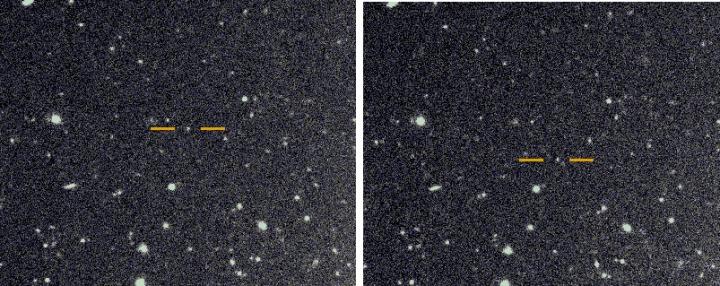Saturn is the new King of Moons – and you can help name the moons just discovered!
The fact that a planet – like the Earth – has only one single companion, is rather unusual in our Solar System. With 79 moons, the giant planet Jupiter previously had the most moons. Now, it’s been surpassed by Saturn, which changed from having 62 to 82 moons in one fell swoop. The new moons around the ringed planet were discovered using the Subaru telescope on Mauna Kea in Hawaii.
Each of the newcomers has a diameter of about 5 km (3 miles). Seventeen of the twenty are orbiting Saturn in the wrong direction, in what is called a retrograde orbit, that is, in the direction opposite the rotation of the planet. The other three complete their circuit around Saturn the proper way, that is, they have prograde orbits. The fact that the moons were only just discovered is due not only to their small sizes, but also to their wide orbits. Only two of the prograde moons are relatively close to Saturn and need about two years to complete one orbit (the Earth’s moon takes one month). The other 18, in contrast, need more than three Earth years to complete their orbits.
Of course, the new moons will also now need new names. So the discoverers are holding a contest – you can enter to name one of Saturn’s newly discovered companions! The competition is running until December 6, 2019. To participate, you must tweet your suggestion to @SaturnLunacy with the hashtag #NameSaturnsMoons and also include why you chose that name. Photos, drawings, or videos are also welcomed.
You’re not completely free to choose any old name you’d like, however. Your suggestions also have to take into consideration the nature of the newly discovered moons. Two of the newcomers (which might be the remnants of a larger moon that broke apart) belong to a group of Saturn’s moons called the Inuit group and therefore must be named after giants from Inuit mythology. Seventeen of the newly discovered moons must be given names of giants from Norse mythology. These might also be fragments from a larger moon. One of them is the farthest prograde moon yet discovered around Saturn. This last one, the twentieth, is similar to Saturn’s moons in the Gallic group, so it will be given the name of a giant from Gallic mythology.
You can look up names that are already in use at the International Astronomical Union’s Minor Planet Center.



There is a holy mountain in Greece called Mount Athos. 60 Minutes did a nice story on the Monks there. Dumas writ the story of The Three Musketeers and one of them was named “Athos”. My name is “Athos “. I love science and science fiction so I nominate “Athos” as the name of one of Saturn’s moons
Let’s call it “Mooney Moon Face”.
Works for boats…